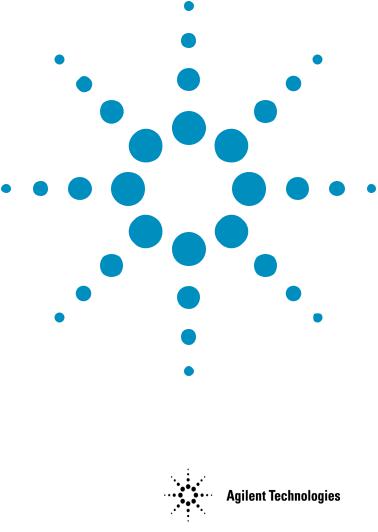Agilent Technologies 54754a, 54753a User Manual

Agilent 54753A and 54754A
TDR Plug-in Modules
Programmer’s Quick Reference

Notices
© Agilent Technologies, Inc. 2000-2004
No part of this manual may be reproduced in any form or by any means (including electronic storage and retrieval or translation into a foreign language) without prior agreement and written consent from Agilent Technologies, Inc. as governed by United States and international copyright lays.
Manual Part Number
54754-90013
Edition
July 2004
Printed in Malaysia
Agilent Technologies, Inc.
Digital Signal Analysis Division
1400 Fountaingrove Parkway
Santa Rosa, CA 95403, USA
Warranty
The material contained in this document is provided “as is,” and is subject to being changed, without notice, in future editions. Further, to the maximum extent permitted by applicable law, Agilent disclaims all warranties, either express or implied, with regard to this manual and any information contained herein, including but not limited to the implied warranties of merchantability and fitness for a particular purpose. Agilent shall not be liable for errors or for incidental or consequential damages in connection with the furnishing, use, or performance of this document or of any information contained herein. Should Agilent and the user have a separate written agreement with warranty terms covering the material in this document that conflict with these terms, the warranty terms in the separate agreement shall control.
Technology Licenses
MS-DOS is a U.S. registered trademark of Microsoft Corporation.
Restricted Rights Legend
If software is for use in the performance of a U.S. Government prime contract or subcontract, Software is delivered and licensed as “Commercial computer software” as defined in DFAR 252.227-7014 (June 1995), or as a “commercial item” as defined in FAR 2.101(a) or as “Restricted computer software” as defined in FAR 52.227-19 (June 1987) or any equivalent agency regulation or contract clause. Use, duplication or disclosure of Software is subject to Agilent Technologies’ standard commercial license terms, and non-DOD Departments and Agencies of the U.S. Government will receive no greater than Restricted Rights as defined in FAR 52.227-19(c)(1-2) (June 1987). U.S. Government users will receive no greater than Limited Rights as defined in FAR 52.227-14 (June 1987) or DFAR 252.2277015 (b)(2) (November 1995), as applicable in any technical data.
Safety Notices
CAUTION
Caution denotes a hazard. It calls attention to a procedure which, if not correctly performed or adhered to, could result in damage to or destruction of the product. Do not proceed beyond a caution sign until the indicated conditions are fully understood and met.
WARNING
Warning denotes a hazard. It calls attention to a procedure which, if not correctly performed or adhered to, could result in injury or loss of life. Do not proceed beyond a warning sign until the indicated conditions are fully understood and met.
ii

Introduction
Introduction
54750A/83480A |
For controlling 54753A and 54754A TDR plug-in modules that are installed in |
Mainframes |
a 54750A or 83480A mainframes, refer to the following books: |
•This manual, the 54753A and 54754A TDR Plug-in Modules Programmer’s Quick Reference
•54753A and 54754A Programmer’s Guide for detailed information.
•54750A Oscilloscope and 83480A Analyzer Programmer’s Guide for information about programming the oscilloscope.
•54753A and 54754A User’s Guide for general information about the operation of the TDR plug-in module.
86100-Series |
For controlling 54753A and 54754A TDR plug-in modules that are installed in |
Mainframes |
an 86100-series mainframe, refer to the following books: |
• |
86100-series programmer’s guide. |
• |
86100-series online help. |
Notational |
computer type. All characters appearing in computer type are key |
Conventions |
words and must be entered exactly as shown. |
|
CAPITAL LETTERS. Capital letters indicate the short form of a command. |
|
The actual command is not case sensitive and can be entered in upper or |
|
lower case. |
|
<>. Angular brackets enclose words or characters that symbolize a program |
|
code parameter or an GPIB command. |
|
::= "is defined as." For example, <A> ::= <B> indicates that <A> can be |
|
replaced by <B> in any statement containing <A>. |
|
| "or." Indicates a choice of one element from a list. For example, <A> | <B> |
|
indicates <A> or <B> but not both. |
|
... An ellipsis (trailing dots) indicate that the preceding element may be |
|
repeated one or more times. |
iii

|
Introduction |
|
[ ] Square brackets indicate that the enclosed items are optional. |
|
{ } When several items are enclosed by braces, one, and only one of these |
|
elements may be selected. |
Definitions |
d ::= A single ASCII numeric character, 0-9. |
|
n ::= A single ASCII non-zero, numeric character, 1-9. |
|
<NL> ::= Newline or Linefeed (ASCII decimal 10). |
|
<sp> ::= space character. |
|
<white_space> ::= space(s) and tabs. |
iv

Contents
Root Level Commands 4
Acquire Commands 7
Calibrate Commands 8
Channel Commands 9
Disk Commands 11
Display Commands 12
Function Commands 13
Histogram Commands 19
Limit Test Commands 20
Marker Commands 21
Mask Test Commands 23
Measure Commands 25
TDR Commands 37
Waveform Commands 41
Waveform Memory Commands 42
3

Root Level Commands
Command :BLANk {CHANnel<number> | WMEMory<number> | FUNCtion <number> | FFT | RESPonse<number> | HISTogram | PMEMory1}
Turns off an active channel, function, waveform memory, pixel memory, FFT, histogram, or TDR response. The VIEW command turns them on.
<number> For channels: an integer, 1 through 4, indicating the slot in which the channel resides, followed by an optional A or B identifying which of two possible channels in the slot is being referenced. For functions: 1 or 2. For waveform memories (WMEMory): 1, 2, 3, or 4. For pixel memories (PMEMory): 1. For TDR response: 1, 2, 3, or 4.
Command :COMMents {PLUGin<number>, <comments>}
Sets the comments field for the plugin. This field is used to describe options included in the plugin, or for user commands about the plugin.
<number> Represents the plugin slot numbered 1 through 4.
<comments> Represents the unquoted string.
4

Root Level Commands
Command :DIGitize [<waveform_name>][,<waveform_name>]
Invokes a special mode of data acquisition that is more efficient than using the RUN command. This command initializes the selected channels, functions, responses, or FFT to “unacquired,” then acquires them according to the current instrument settings. When all signals are completely acquired, the instrument is stopped.
<waveform_name> {CHANnel<number> | FUNCtion<number> | FFT | RESPonse<number>}
<number> For channels: an integer, 1 through 4, indicating the slot in which the channel resides, followed by an optional A or B identifying which of two possible channels in the slot is being referenced. For functions: 1 or 2. For responses: 1, 2, 3, or 4.
Command :MENU {APPLication | CHANnel<number> | ACQuire | TIMebase | TRIGger | DISK | DISPlay | MARker | MEASure | MATH | WAVeform | SETup | PRINt | HELP | UTILity | FFT | LTESt | HISTogram | MTESt | MEYE | TDR<number> | MTDR<number>}
<number> For channels, indicates the slot (1 through 4) in which the channel resides, followed by an optional A or B identifying which of two possible channels in the slot is being referenced.
For TDR, controls the TDR/TDT menus for channels 2 and 4. For MTDR, controls the TDR/TDT menus for channels 2 and 4.
5

Root Level Commands
Command :STORe:WAVEform {CHANnel<number> |
FUNCtion<number> | WMEMory<number> | HISTogram |
FFT | RESPonse<number>},{WMEMory<number>}
Copies a channel, function, stored waveform, histogram, TDR response, or FFT to a waveform memory. The first parameters specifies the source of the copy and can be any channel, function, waveform memory, histogram, TDR response, or the FFT. The second parameter is the destination of the copy, and can be any waveform memory.
<number> For channels: an integer, 1 through 4, indicating the slot in which the channel resides, followed by an optional A or B identifying which of two possible channels in the slot is being referenced. For functions: 1 or 2. For waveform memories (WMEMory): 1, 2, 3, or 4. For responses: 1, 2, 3, or 4.
Command :VIEW {CHANnel<number> | WMEMory<number> |
FUNCtion<number> | FFT | RESPonse<number> |
HISTogram | PMEMory1}
Turns on a channel, function, pixel memory, waveform memory, TDR response, histogram, or FFT. Use the BLANk command to turn these off.
<number> For channels: an integer, 1 through 4, indicating the slot in which the channel resides, followed by an optional A or B identifying which of two possible channels in the slot is being referenced. For functions: 1 or 2. For waveform memories (WMEMory): 1, 2, 3, or 4. For TDR responses: 1, 2, 3, or 4. For pixel memories (PMEMory): 1.
6

Acquire Commands
Command :ACQuire:BEST[?] {THRuput | FLATness}
When averaging is enabled with ACQuire:AVERage, the FLATness option improves the step flatness by using a signal processing algorithm within the instrument. You should use this option when performing TDR measurements or when step flatness is important. The THRuput option improves the instrument’s throughput and should be used whenever best flatness is not required.
7

Calibrate Commands
Command :CALibrate:SAMPlers[?] {DISable | ENABle}
Enables or disables the samplers in the plug-in.
8

Channel Commands
Command :CHANnel<number>:OFFSet[?] <offset_value>
For TDR and TDT applications, you may change the offset to magnify offset in some circumstances. This command is used to set the magnify offset as well as the offset.
<number> An integer, 1-4, indicating the slot in which the channel resides.
<offset_value> Offset value at center screen; can be volts, amperes, or other units.
Command :CHANnel<number>:RANGe[?] <range_value>
For TDR and TDT applications, you may change the range to magnify range in some circumstances. This command is used to set the magnify range as well as the range.
<number> An integer, 1-4, indicating the slot in which the channel resides.
<range_value> Full-scale voltage of the specified channel number.
Command :CHANnel<number>:SCALe[?] <scale_value>
For TDR and TDT applications, you may change the scale to magnify scale in some circumstances. This command is used to set the magnify scale as well as the scale.
<number> An integer, 1-4, indicating the slot in which the channel resides.
<scale_value> Vertical scale of the channel in units per division.
9

Channel Commands
Command :CHANnel<number>:TDRSkew <percent> [%]
This command sets the TDR skew for the given channel. The TDR skew control moves the TDR step relative to the trigger position. The control may be set from -100 to 100 percent of the allowable range. This command is only applicable to TDR channels.
<number> An integer, 1 through 4, indicating the slot in which the channel resides, followed by an optional A or B identifying which of two possible channels in the slot is being referenced.
<percent> A number between -100 and 100, used to set the step position.
Command :CHANnel<number>:UNITs[?] {VOLT | AMPere | WATT | UNKNown | OHM | REFLect | GAIN}
For TDR and TDT applications, you can select the units OHM, REFLect, and GAIN. OHM and REFLect may be selected for TDR channels, while GAIN may be selected for TDT channels. You must perform a normalization and a reference plane calibration to select these units.
<number> An integer, 1-4, indicating the slot in which the channel resides.
10

Disk Commands
Command :DISK:LOAD "<filename>", <source>
Loads a setup, waveform, database, mask, TDR/TDT calibration, or pixel memory from the disk. The filename does not include a suffix. The suffix supplied by the instrument depends on the source and file format specified. The TDRTDT option is a file type choice used to load TDR/TDT calibration values into the instrument.
<source> {DATabase | MASK | PMEMory 1 | SETup | WMEMory<number> | TDRTDT}
<filename> Is an MS-DOS compatible file name up to 8 characters long.
<number> Represents waveforms 1, 2, 3, or 4.
Command :DISK:STORe <source>, "<filename>"[,<format>]
Stores a setup, waveform, database, mask, TDR response, TDR/TDT calibration, or pixel memory to the disk. The filename does not include a suffix. The suffix is supplied by the instrument depending on the source and file format specified. The database may only be saved in internal format.
<source> {DATabase | MASK | PMEMory 1 | SETup | WMEMory<number> | TDRTDT}
<filename> Is an MS-DOS compatible file name up to 8 characters long.
<number> Represents waveforms 1, 2, 3, or 4.
<format> {TEXT [,YVALues | VERBose] | INTernal}
11

Display Commands
Command :DISPlay:ASSign[?] {CHANnel<number> |
FUNCtion<number> | RESPonse<number> |
WMEMory<number> | FFT},{UPPer | LOWer}
Assigns the specified channel, waveform, function, TDR response, or FFT to a particular portion of the waveform area on the screen. This command has no effect when the graticule format is single.
<number> For channels: an integer, 1 through 4, indicating the slot in which the channel resides, followed by an optional A or B identifying which of two possible channels in the slot is being referenced. For functions: 1 or 2. For waveform memories (WMEMory): 1, 2, 3, or 4. For TDR responses: 1, 2, 3, or 4.
12
